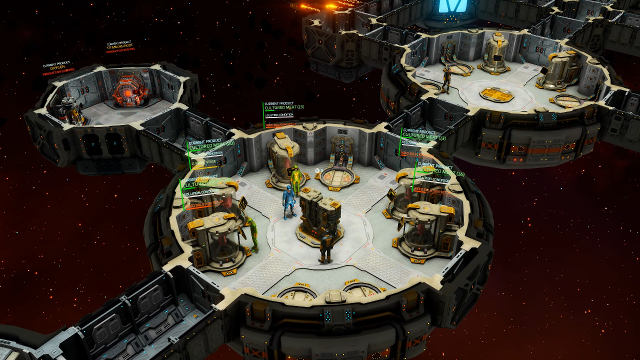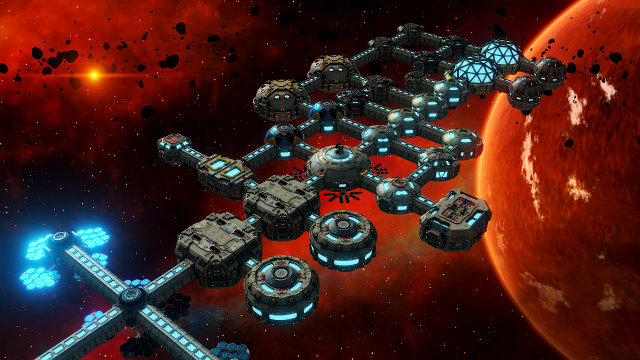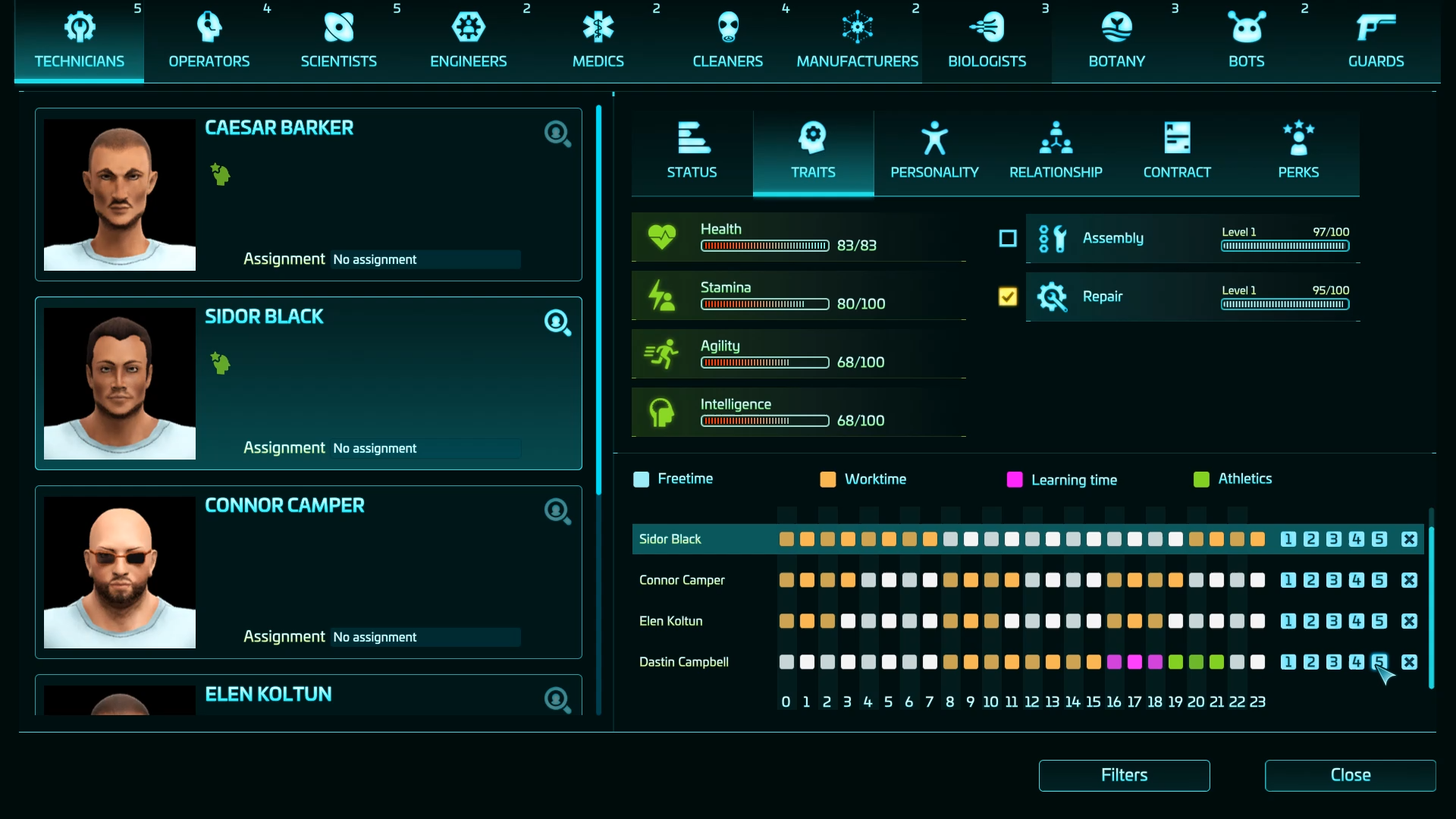Space-based games are my thing. From my middle school days of Freelancer to presently finishing Alien: Isolation on my Twitch channel, I enjoy space in its many genres. So when Base One slid across my virtual desk, I had to take it for a spin.
Base One is a space station sim game with survival elements and RPG mechanics where you, an intrepid explorer, find yourself on the other end of a wormhole that opened up near Earth’s moon, tearing it apart and causing extreme weather on Earth.
The catastrophe has inhibited the planet’s ability to sustain the human race. Things aren’t much better on the other side of the wormhole, however, as you’ll find out in the first chapter of the campaign, which does a good job holding your hand through the basics of the game with a progressive tutorial system.
Base One Review: A Stellar Addition to the Survival RPG Genre
Your starting crew is composed of two technicians — the people who build and maintain the modules and devices on the space station — and a lone scientist, your researcher who toils away in the Lab unlocking more technologies for upgrades, module efficiency, and new areas for the sizable selection of crew to work in.
Aside from technicians and scientists, there are nine other crewmember classes to hire depending on your current researched tech and unlocked modules for your station. Before we get too into that, though, let’s circle back to the starting hub and base building.
The starting hub module has the minimum base functions covered, but it’s far from ideal. The survival element of the game starts as soon as you begin to expand the size of the station. Modules require heat and oxygen to be habitable, so you’ll need to build a life support module for that, and then build an E.L.D. within the module, as well as a Battery to power it. But what powers the battery? Well, initially, nothing — until you build a Solar panel module and connect the battery to it.
This is the beginning of the strategic, big-picture mode of Base One.
Modules have finite room for internals, so your base life support module can only have four upgrades inside of it, meaning that, at most, you can run three E.L.D. and one Battery before you’re out of space. You can research a larger life support module through the tech tree later on, but you must still plan the design of your base with expansion in mind — and expand you must in order to survive.
Because of this, you’ll find that in the early- to mid-game, you’ll likely have to do a bit of micromanaging when it comes to power; switching devices on and off to make sure you don’t run out of power until you have something more than day/night dependent solar.
Aside from this top-level builder gameplay, Base One takes it a step further with the crew members themselves.
Your crew has specific jobs, personalities, and traits, both positive and negative. This means you have to weigh the pros and cons of hiring certain people. Technician James may have high assembly and repair skills, but his envious trait makes for sour work shifts with technician Sarah, who has the gifted trait.
You can even this out a bit by scheduling staggered crew work shifts, which is helpful in saving materials in the early game. For example, day/night shifts allow your crew to “hot bunk” in order to cut down on crew quarters needed.
The Base One user interface is pretty straightforward, with all of the primary navigation taking place on the bar at the top of the screen. It didn’t take long for me to figure out how to navigate it, and it’s not overly cumbersome or obtrusive, allowing what’s happening on the screen in your station to take center stage.
The music and sound effects are fairly standard fare and pretty basic in that nothing really stands out. It’s not low-quality or poorly done, but it’s not something that’s going to be particularly memorable like Endless Space 2 or Risk of Rain’s soundtrack.
One area that could use some more attention is the voice acting. The spoken dialogue sections are emotionless and monotone, coupled with the slow transition between screens, like when interacting with the mission givers in the Transmission screen feeling slow and monotonous.
Graphically, Base One is a pretty game. The designs for the various station modules and internals look good. The character models are a bit on the cartoony side, though, where they feel a bit laughable to look at, especially in the crew overview UI. But it’s not really an issue that impacts gameplay.
Base One plays like most other builder/management games, and it has a very similar game loop of build > research > collect/produce > upgrade. As you expand your station, you’ll hire more crew, which means more crew serving modules like gyms, quarters, and lounges.
More advanced modules and internal upgrades require more building supplies that you either buy or build. Random events can happen, as well, like defending against an incoming asteroid storm, having an internal upgrade explode due to too much wear, or one of your crew pooping themselves because you didn’t make sure there was water going to the showers and toilets you built them.
Playing in the freeplay mode, you’ll find that you have weekly performance charts, where you earn loyalty points towards cheaper supply prices and cash rewards. Even at the verge of destruction, someone has to foot the bill for goods and services.
Base One Review — The Bottom Line

Pros
- Intuitive UI
- Attractive graphics
- Good progressive campaign
Cons
- Flat audio and voice acting
- Possibly too much micromanagement for new players to the genre
Base One is a good survival RPG game set in space. There’s a level of strategy involved when it comes to crew selection, tech research, and building out your station. It feels like some areas could use a bit more attention, particularly the voice acting and audio, but otherwise, the controls and the core game loop feel good.
There is DLC already planned, according to developer Pixfroze, so you’ll have more to do on the horizon if you choose to give it a go.
Overall, Base One is an enjoyable experience that you can play casually for a few in-game cycles or a few IRL hours. It doesn’t really bring anything new or innovative to the table but executes well the familiar game mechanics that make up its loop.
[Note: Pixfroze provided the copy of Base One used for this review.]








Published: May 7, 2021 02:30 pm